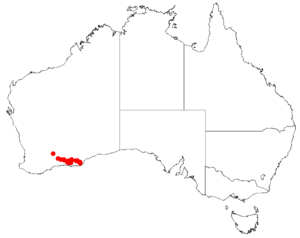Persoonia cymbifolia facts for kids
Quick facts for kids Persoonia cymbifolia |
|
|---|---|
| Conservation status | |
| Scientific classification | |
| Genus: |
Persoonia
|
| Species: |
cymbifolia
|
 |
|
| Occurrence data from Australasian Virtual Herbarium | |
Persoonia cymbifolia is a type of flowering plant that belongs to the Proteaceae family. It is found only in the southern part of Western Australia, meaning it is endemic there. This plant is a shrub that grows upright and spreads out. It has smooth bark, and its young branches have tiny hairs. Its leaves are long and narrow, and its yellow flowers grow alone or in small groups.
What Does This Plant Look Like?
Persoonia cymbifolia is a shrub that typically grows to be about 20 to 60 centimeters tall. It has smooth bark that looks mottled (patchy) grey. Its young branches are covered in dense, soft hairs.
The leaves of this plant are arranged one after another along the stem. They are long and narrow, usually about 1.5 to 4.5 centimeters long and 1 to 3 millimeters wide.
The yellow flowers grow either by themselves, in pairs, or in groups of three. They are found along a very short stem, about 1 millimeter long, called a rachis. After the flowers bloom, this short stem can grow into a leafy shoot. Each flower sits on a small stalk, called a pedicel, which is about 2 to 3.5 millimeters long.
The flower parts that look like petals, called tepals, are yellow and measure about 7 to 11.5 millimeters long. They have hairs on the outside. Inside the flowers, there are yellow anthers, which are parts that hold pollen. This plant usually flowers from December to January.
How It Got Its Name
Scientists officially named Persoonia cymbifolia in 1994. A scientist named Peter Weston first described it in a science journal called Telopea. He studied plant samples that William R. Archer collected in 1991. These samples were found near Mount Ridley, which is north-east of Esperance in Australia.
Where Does It Grow?
This plant, also known as a geebung, grows in areas with low, shrubby plants called 'heath'. You can find it in national parks like Frank Hann National Park and Cape Arid National Park. These areas are located in the Coolgardie, Esperance Plains, and Mallee biogeographic regions of Western Australia. These regions are like different natural zones with specific types of plants and animals.
Is It Protected?
The Government of Western Australia's Department of Parks and Wildlife has classified Persoonia cymbifolia as "Priority Three". This means that scientists do not know much about this plant, and it is found in only a few places. However, it is not currently in immediate danger of disappearing.


